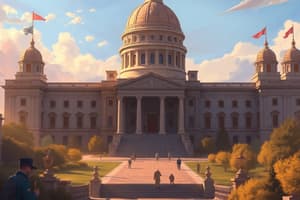Podcast
Questions and Answers
What determines the number of seats each state gets in the House of Representatives?
What determines the number of seats each state gets in the House of Representatives?
Apportionments
What is a congressional district?
What is a congressional district?
A geographic area served by one member in the House of Representatives.
Who or what gets to determine the lines of a congressional district?
Who or what gets to determine the lines of a congressional district?
The state legislature
What does the 'one person, one vote' rule mean?
What does the 'one person, one vote' rule mean?
What are the two types of representation that exist?
What are the two types of representation that exist?
Why are incumbents more likely to win office than their challengers?
Why are incumbents more likely to win office than their challengers?
When is public opinion most and least likely to affect members of Congress?
When is public opinion most and least likely to affect members of Congress?
Who helps inform members of Congress about specific issues?
Who helps inform members of Congress about specific issues?
What role does the Vice President have in Congress?
What role does the Vice President have in Congress?
If the House and Senate pass a bill, what must happen before sending it to the President?
If the House and Senate pass a bill, what must happen before sending it to the President?
How does debate work in the House of Representatives?
How does debate work in the House of Representatives?
What happens to a bill after it is introduced?
What happens to a bill after it is introduced?
What happens after the House and Senate have worked out a compromise bill in the conference committee?
What happens after the House and Senate have worked out a compromise bill in the conference committee?
What are the different types of committees that exist in Congress?
What are the different types of committees that exist in Congress?
Flashcards are hidden until you start studying
Study Notes
Congressional Representation
- Seats in the House of Representatives are apportioned based on population, determined every ten years by the census. Each state gets at least one representative.
- A congressional district is a geographic area represented by one member of the House; California has 53 representatives for its 53 districts.
- District lines are usually drawn by state legislatures, often influenced by the majority party, though some states use bipartisan or nonpartisan commissions.
Voting and Representation Types
- The "one person, one vote" rule ensures that legislative districts maintain equal population sizes to grant equivalent voting power, as established in Reynolds v. Sims.
- Two representation types: instructed delegate representation (votes according to constituents' wishes) and trustee representation (makes decisions based on personal judgment).
Incumbency and Public Opinion
- Incumbents have a higher likelihood of winning elections due to public recognition, access to campaign finance, government resources, and established trust with voters.
- Public opinion influences congressional decisions more when issues are salient and constituents are informed; less influence occurs when public interest is low or divided.
Congressional Leadership and Processes
- Whips assist in informing members of Congress about issues and gauging party support on matters.
- The Vice President serves as the presiding officer of the Senate and fulfills ceremonial roles within the President's administration.
Legislative Process
- After passing in the House and Senate, a bill must be signed by the President or it can be vetoed—overriding a veto requires a two-thirds vote from both chambers.
- Debate in the House of Representatives is structured and limited; leadership controls who speaks and for what duration.
- Bills are introduced and initially read; they are then referred to committees for markup.
Conference Committees and Types of Committees
- If the House and Senate create different versions of a bill, it will go to a conference committee, which drafts a compromise version that must be accepted by both chambers.
- Types of committees include standing committees (permanent legislative bodies), subcommittees (focused on specific issues), and special/select committees (formed for particular tasks or investigations).
Studying That Suits You
Use AI to generate personalized quizzes and flashcards to suit your learning preferences.




